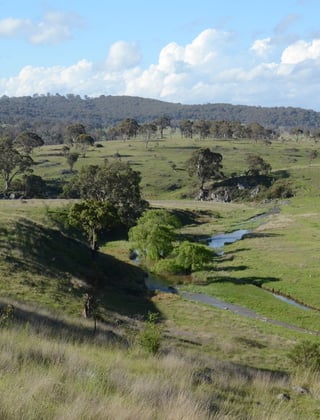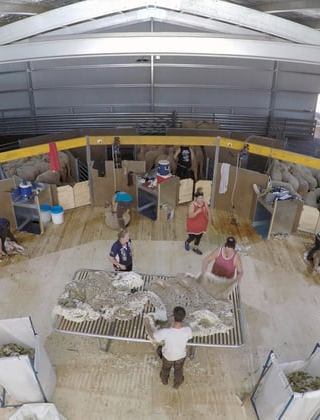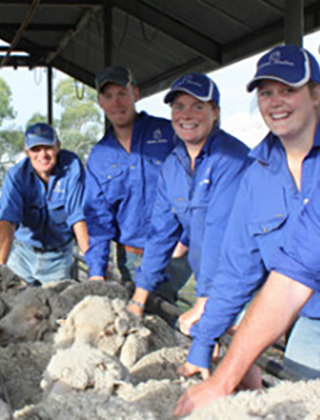Efficient, productive and green at Nareen
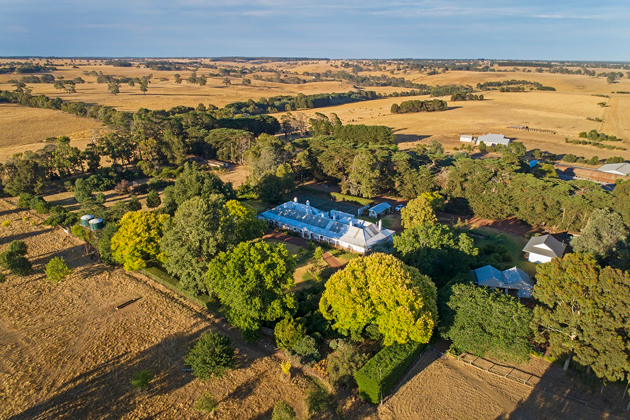
Based near Coleraine in the rolling redgum country of western Victoria, Nareen Station Pty Ltd is a family-owned business that invests in efficiently producing fine Merino wool from healthy, productive sheep, while building and protecting the natural resources of the landscape.
An icon of fine Merino wool-growing in the heart of Victoria’s Western Districts, ‘Nareen Station’ was purchased by Gordon and Alexandra Dickinson in 1996.
They have since expanded the property to about 3,800 hectares and added the neighbouring 3,500-hectare ‘Barrama’ property, plus 2,000-hectare ‘Boyong’ near Robe in South Australia, to their family-owned Nareen Station Pty Ltd grazing business.
Across the three properties, the Dickinsons run commercial and stud Merino sheep, and beef cattle. Their sheep type is a plain bodied poll, with adults cutting 5.5 kg of 18-19 micron wool.
Nareen and Barrama are both breeding properties, each running 12,000 breeding ewes and joining 1,000 cows, and Boyong is used for finishing stock and growing out retention heifers. The commercial sheep enterprise usually achieves about 100 percent of lambs marked to ewes joined.
Commitment to the industry
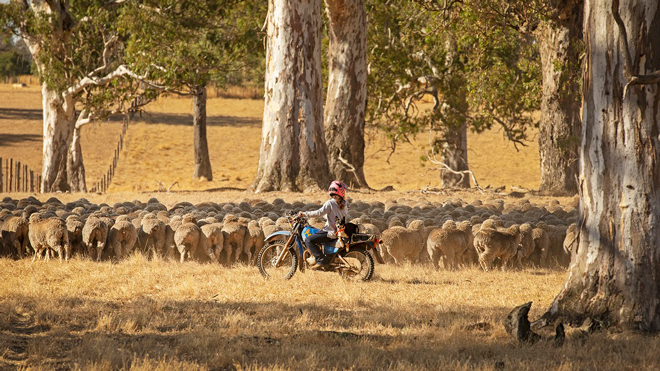
Mustering the fine Merino sheep at Nareen in western Victoria.
“Clearly the industry is going through one of its occasional down swings this year, but we remain confident and committed to meat and wool production as the best use of productive agricultural land in our district, where winter waterlogging makes cropping a very challenging exercise,” Gordon said.
Nareen and Barrama have a Mediterranean climate with hot dry summers and long wet winters with up to 200 wet days a year.
“The two properties have approximately 650mm of rainfall and have clay loam soils. Boyong has similar rainfall on a sandy loam but has the benefit of underground water allowing irrigation through two 50-hectare pivots with lucerne pastures for lamb finishing,” Gordon said.
“The business runs an average of 110,000 DSE through the year, with a near 50/50 mix between sheep and cattle.”
The ewes of the Merino flock lamb onto the spring flush of feed.
“We have invested in genetics which allow that lamb to quickly reach a satisfactory weaning weight before going into a hot dry summer. Our business is then set up to sell surplus Merino wethers and ewes to other farmers who want to run them but not have to breed them. We have established long term relationships with many of these buyers,” Gordon said.
“We run our own stud to produce the commercial rams required. The stud came with Barrama when it was purchased 25 years ago from the Learmonth family. We source external genetics from leading studs as well as our own retention sires. We invest heavily in the best genetics we can identify which we think are suitable for south of the divide with a long, wet winter.”
Transformational new shearing shed
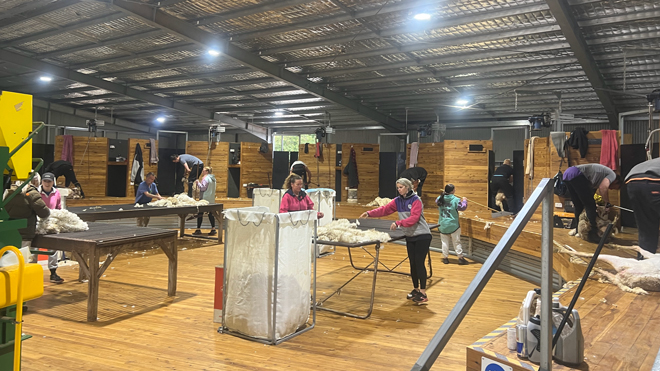
The new shed at Barrama that is based on the AWI Shearing Shed Design.
Gordon runs an efficient operation which means the business has installed and maintains good infrastructure – including fences, laneways, roads and water – across the properties.
“We have lane and road access to virtually all paddocks, and we aim to have each set of sheep yards servicing about 800 hectares, five at each of Barrama and Nareen,” Gordon said.
The good infrastructure extends to the business’s shearing sheds.
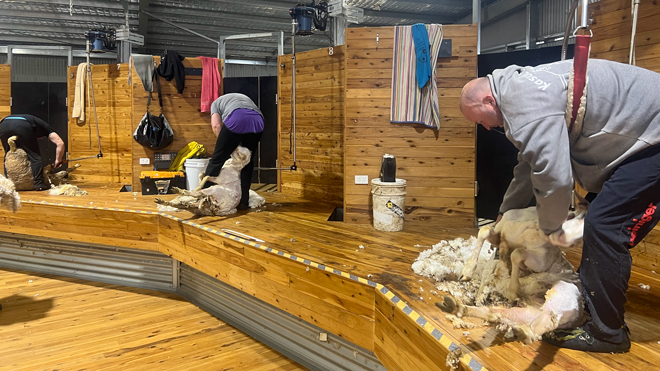
“Nareen Station has a 10-stand shearing shed, with five stands either side of a central wool handling area and undercover capacity of a little over 2,000 woolly sheep,” Gordon said.
At the Barrama shearing shed, Gordon was keen to invest in efficiency for staff and contractors as well as animal welfare.
“Barrama had an eight-stand shed with an undercover capacity of 1,100 sheep. But with the improvements in plain bodied sheep and wide gear, the shearers were consistently shearing 1,500 to 1,600 a day,” he said.
“In addition, the holding and forcing pens were laid out in a traditional manner, meaning all the sheep required a lot of effort and persuasion from dogs to keep moving forward towards the catching pens.
“It had a long thin board with our wool handling team trapped in a small area at one end of the board with a wall of wool being rushed up the board towards them. Something had to change!”
So in 2021, Gordon and his team set about researching a design for a new shed that would best suit the operation at Barrama.
“We had a close look at a number of sheds that had been built in our general area, including some that had used the AWI Shearing Shed Design, albeit on a smaller scale. We had decided to sit the new shed alongside the old one to utilise the holding room and to be able to use the old board for crutching plants etc, so we were particularly focussed on improving the workflows in the new shed rather than having to build an enormous new holding area,” he said.
“As we reviewed the alternatives to improve sheep and wool flows, we decided that it would make more sense to use the extensive work AWI had done in these areas rather than try and work it out ourselves.”
AWI’s Shearing Shed Design (www.wool.com/sheddesign) is a result of AWI and a working group of woolgrowers and shed staff in 2019 designing a shearing shed which addresses worker safety and animal welfare considerations, while also achieving improved shed efficiency and good wool quality outcomes.
The design was developed following extensive industry consultation with some of the most experienced shearers, wool handlers, classers and woolgrowers from across Australia. Multiple trials led to refinements and a final design. Dozens of sheds have now been built across the country using the AWI design.
“Based on the AWI Shearing Shed Design, we last year built a nine-stand raised board in a horseshoe shape, with one of the nine for left handers,” Gordon said.
“We first used the shed in March this year and the transformation has been remarkable. The penning up is now done by our contractor’s father, who doesn’t need to use his dogs to keep up.
“The wool handling has gone from a frantic process to a very calm one where we have stopped using wool bins and now have four presses sitting behind the wool tables, with three of them being the different fleece lines and one for a rotating oddment bale as wool packs bank up. This has meant the presser is putting out his 45 bales a day very easily and able to spend a significant part of his time helping with clip preparation.
“Shearers are now on a straight drag out of the pens with the let-out chutes working particularly well.
“The stress has gone out of the wool room and we now have total undercover storage for 2,000 sheep, which allows a full day and a run the next morning, which gives us a good chance to keep the shed working.”
Staff are valued at Nareen
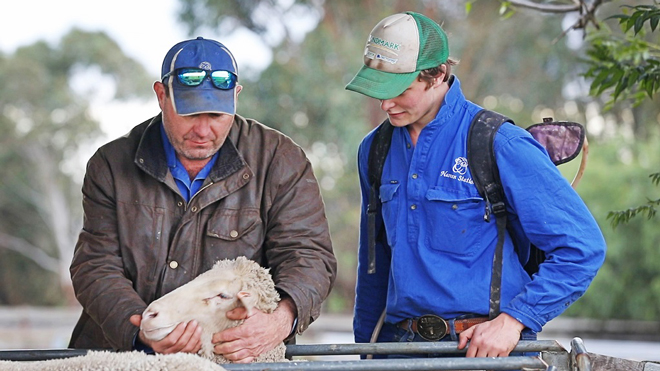
Nareen runs its own 12-month jackeroo/jillaroo program for youngsters wanting to gain practical experience and skills.
Just as a modern and efficient shearing shed makes it easier for a business to attract and retain wool harvesting staff, providing a good work environment across the broader farm business helps attract and retain good farm staff – as is the case at Nareen Station Pty Ltd.
“We can only make the business work with good people. We have a permanent team of 12 spread across the three properties,” Gordon said.
All staff live on-farm in furnished housing. The company promotes a balanced social and work environment, encouraging local sport and involvement in other activities.
“We use contractors extensively for specialist tasks and spend most of our time managing animal health and nutrition and ensuring the infrastructure is maintained.”
Nareen Station Pty Ltd also has 12-month jackeroo/jillaroo positions available to be part of its team. These positions suit young people preparing for a career in agriculture, including before and during tertiary study. Skills gained include livestock husbandry, fencing, small machinery use, working in a team environment, grazing management and animal welfare.
“For the past 20 years we have had two or three jackeroos and jilleroos as part of the team each year, with many of them then going on to study agriculture at a tertiary level. We have been able to put almost all of them through relevant training courses including the ones run with AWI support, such as the Lifetime Ewe Management (LTEM) course,” Gordon said.
The LTEM course (www.wool.com/LTEM) aims to increase producers’ understanding of the influence of ewe nutrition and management on overall reproduction rates and lamb and ewe survival. Producers develop the skills to manage their ewes to achieve condition score targets and explore the economics of supplementary feeding and pasture management to review stocking rates.
Good environmental management
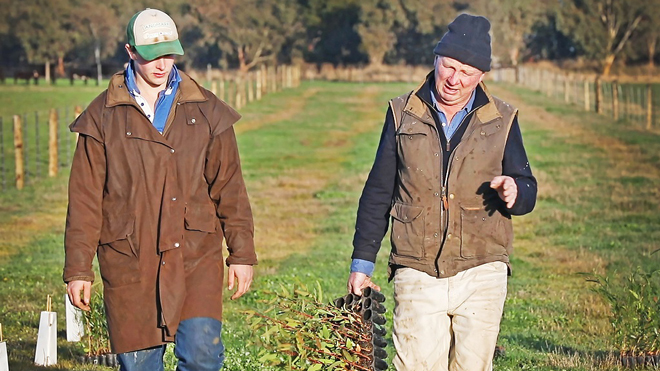
A tree planting program helps provide shelter for stock, stability for the soil, and a carbon sink.
Gordon says he takes great pride on being environmentally responsible with a 20-year history of tree planting, natural regeneration, enhanced biodiversity, waterway protection and low stress animal production on the three properties. Being in a relatively high rainfall area presents challenges for soil erosion and stock shelter.
“We now have approximately seven percent of our land area in shelter belts providing regeneration of flora, wind protection for stock and helping soil stability in the waterways. This work has been part of fencing to contours but also embedded in our laneways for efficient and attractive micro-environments,” Gordon said.
“We have a significant number of original paddock trees, but we have supplemented this with significant blocks of trees in paddocks for shade and shelter. After a trip to New Zealand looking at farms, we have adopted their practice of agroforestry plantations in underutilised areas of the farms. These might be steep, or across waterways where animals and people tend not to go.
“With the additional pressure now for farmers to reduce their carbon footprint, we have expanded this agroforestry to be planting 20-30 hectares a year of pinus radiata. This has already had a significant effect on improving our carbon intensity and our medium-term objective to be carbon neutral feels achievable.
“The products we produce, high quality wool and meat, are largely sold into premium western markets where the buyers are becoming increasingly focussed on the production status of what they are buying. We have to go with it.”
More information: www.nareenstation.com.au






